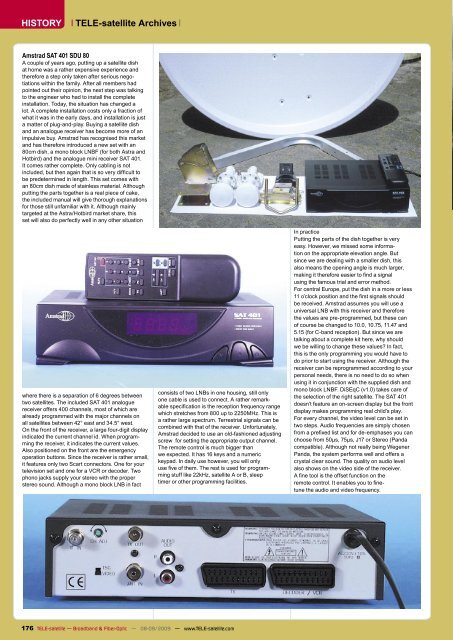08-09 - TELE-satellite International Magazine
08-09 - TELE-satellite International Magazine
08-09 - TELE-satellite International Magazine
You also want an ePaper? Increase the reach of your titles
YUMPU automatically turns print PDFs into web optimized ePapers that Google loves.
HISTORY<br />
<strong>TELE</strong>-<strong>satellite</strong> Archives<br />
Amstrad SAT 401 SDU 80<br />
A couple of years ago, putting up a <strong>satellite</strong> dish<br />
at home was a rather expensive experience and<br />
therefore a step only taken after serious negotiations<br />
within the family. After all members had<br />
pointed out their opinion, the next step was talking<br />
to the engineer who had to install the complete<br />
installation. Today, the situation has changed a<br />
lot. A complete installation costs only a fraction of<br />
what it was in the early days, and installation is just<br />
a matter of plug-and-play. Buying a <strong>satellite</strong> dish<br />
and an analogue receiver has become more of an<br />
impulsive buy. Amstrad has recognised this market<br />
and has therefore introduced a new set with an<br />
80cm dish, a mono block LNBF (for both Astra and<br />
Hotbird) and the analogue mini receiver SAT 401.<br />
It comes rather complete. Only cabling is not<br />
included, but then again that is so very difficult to<br />
be predetermined in length. This set comes with<br />
an 80cm dish made of stainless material. Although<br />
putting the parts together is a real piece of cake,<br />
the included manual will give thorough explanations<br />
for those still unfamiliar with it. Although mainly<br />
targeted at the Astra/Hotbird market share, this<br />
set will also do perfectly well in any other situation<br />
where there is a separation of 6 degrees between<br />
two <strong>satellite</strong>s. The included SAT 401 analogue<br />
receiver offers 400 channels, most of which are<br />
already programmed with the major channels on<br />
all <strong>satellite</strong>s between 42° east and 34.5° west.<br />
On the front of the receiver, a large four-digit display<br />
indicated the current channel id. When programming<br />
the receiver, it indicates the current values.<br />
Also positioned on the front are the emergency<br />
operation buttons. Since the receiver is rather small,<br />
it features only two Scart connectors. One for your<br />
television set and one for a VCR or decoder. Two<br />
phono jacks supply your stereo with the proper<br />
stereo sound. Although a mono block LNB in fact<br />
consists of two LNBs in one housing, still only<br />
one cable is used to connect. A rather remarkable<br />
specification is the reception frequency range<br />
which stretches from 800 up to 2250MHz. This is<br />
a rather large spectrum. Terrestrial signals can be<br />
combined with that of the receiver. Unfortunately,<br />
Amstrad decided to use an old-fashioned adjusting<br />
screw for setting the appropriate output channel.<br />
The remote control is much bigger than<br />
we expected. It has 16 keys and a numeric<br />
keypad. In daily use however, you will only<br />
use five of them. The rest is used for programming<br />
stuff like 22kHz, <strong>satellite</strong> A or B, sleep<br />
timer or other programming facilities.<br />
176 <strong>TELE</strong>-<strong>satellite</strong> — Broadband & Fiber-Optic — <strong>08</strong>-<strong>09</strong>/20<strong>09</strong> — www.<strong>TELE</strong>-<strong>satellite</strong>.com<br />
In practice<br />
Putting the parts of the dish together is very<br />
easy. However, we missed some information<br />
on the appropriate elevation angle. But<br />
since we are dealing with a smaller dish, this<br />
also means the opening angle is much larger,<br />
making it therefore easier to find a signal<br />
using the famous trial and error method.<br />
For central Europe, put the dish in a more or less<br />
11 o’clock position and the first signals should<br />
be received. Amstrad assumes you will use a<br />
universal LNB with this receiver and therefore<br />
the values are pre-programmed, but these can<br />
of course be changed to 10.0, 10.75, 11.47 and<br />
5.15 (for C-band reception). But since we are<br />
talking about a complete kit here, why should<br />
we be willing to change these values? In fact,<br />
this is the only programming you would have to<br />
do prior to start using the receiver. Although the<br />
receiver can be reprogrammed according to your<br />
personal needs, there is no need to do so when<br />
using it in conjunction with the supplied dish and<br />
mono block LNBF. DiSEqC (v1.0) takes care of<br />
the selection of the right <strong>satellite</strong>. The SAT 401<br />
doesn’t feature an on-screen display but the front<br />
display makes programming real child’s play.<br />
For every channel, the video level can be set in<br />
two steps. Audio frequencies are simply chosen<br />
from a prefixed list and for de-emphases you can<br />
choose from 50µs, 75µs, J17 or Stereo (Panda<br />
compatible). Although not really being Wegener<br />
Panda, the system performs well and offers a<br />
crystal clear sound. The quality on audio level<br />
also shows on the video side of the receiver.<br />
A fine tool is the offset function on the<br />
remote control. It enables you to finetune<br />
the audio and video frequency.

















